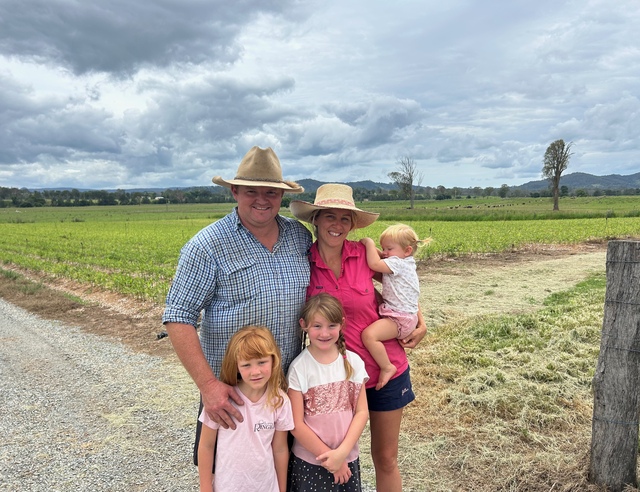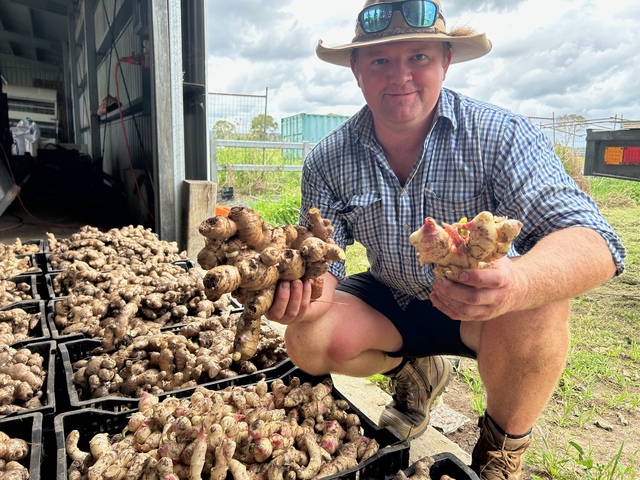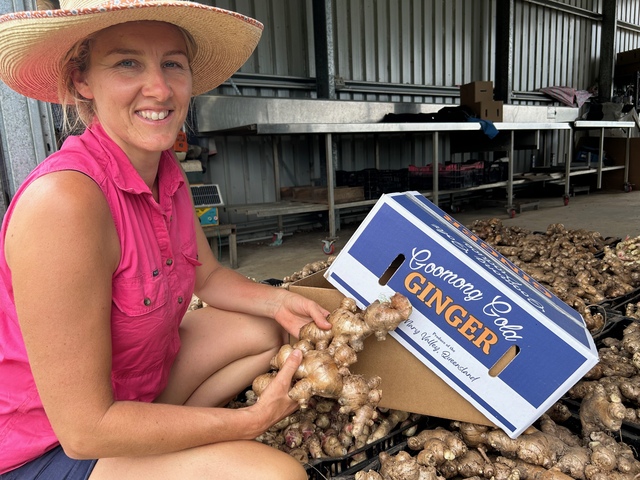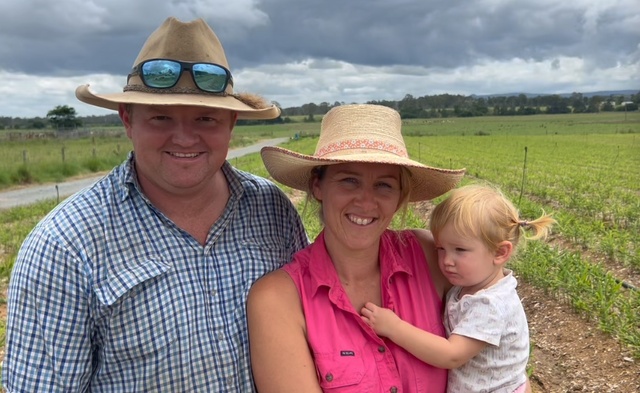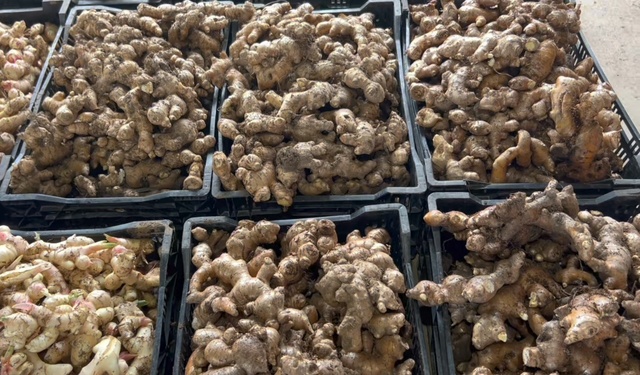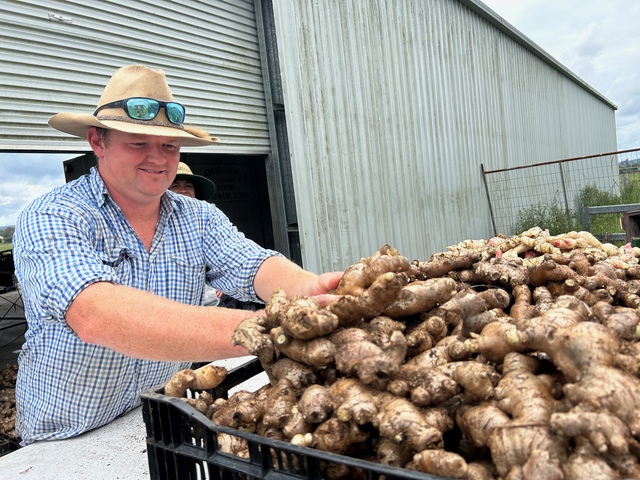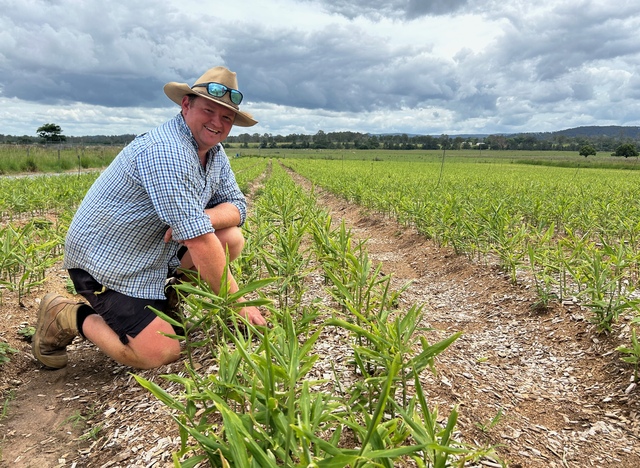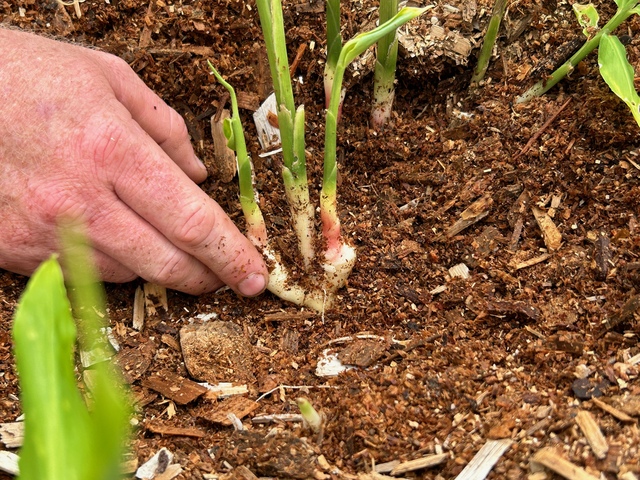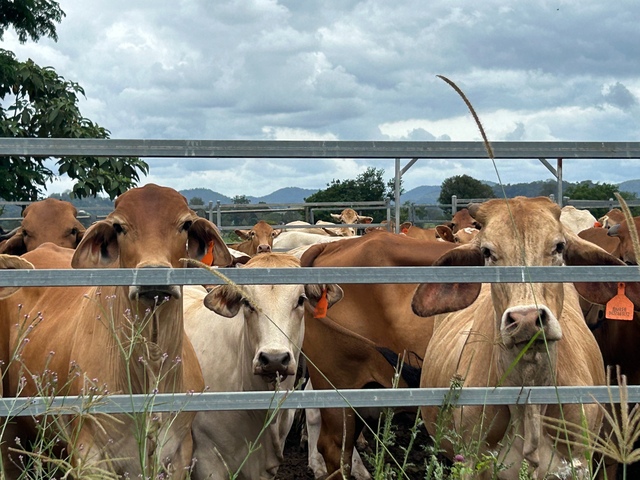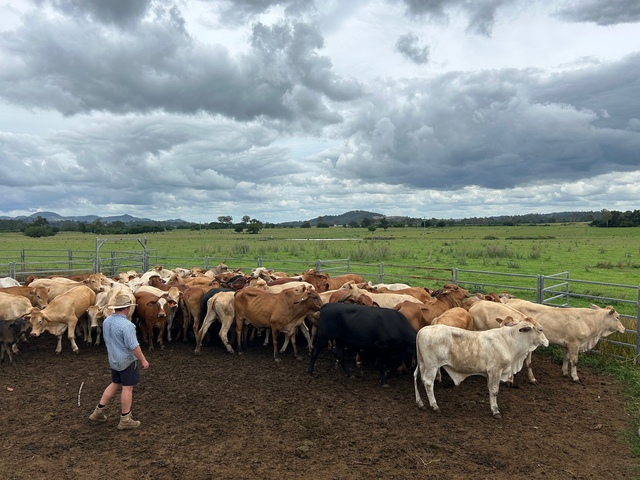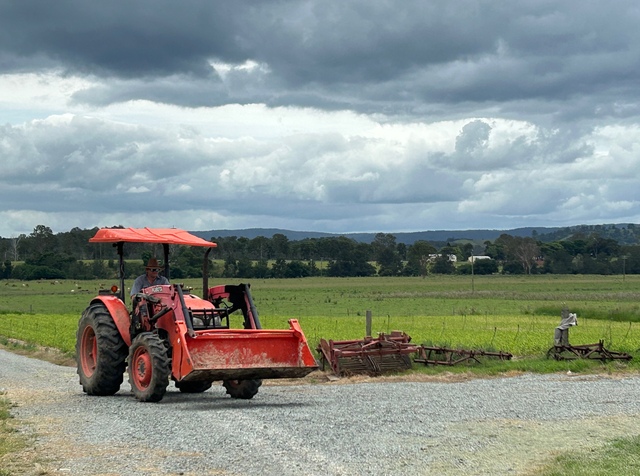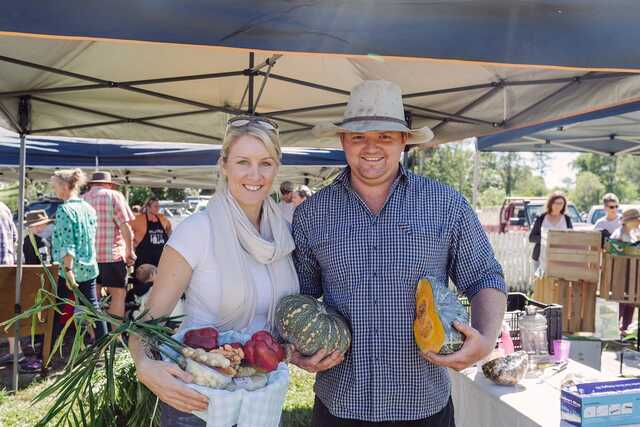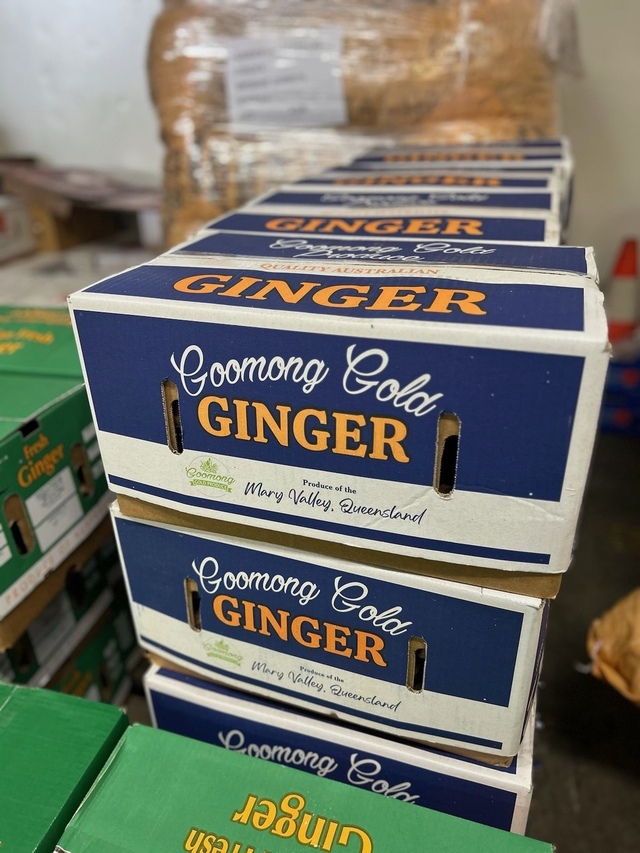Life throws you some curveballs and you never know how you’re going to respond until that happens.
The role of those on the land can be fulfilling, especially in seasons when the dams are full, the grass is high and the markets are good.
Yet it can be a roller-coaster ride when things swing the other way.
Rowan and Ashleigh Kahler at Kandanga know this only too well.
Optimistic and energetic, they are farming about 100 acres of rich Mary River flat country.
Most of the property is for cattle but they have been farming about 20acres under small crops on a rotational basis.
Ginger is what they have settled on as it was troublesome trying to dry garlic for market due to the humid conditions.
Rowan tried pumpkins as well in land that had been under ginger but a season that started out in near-drought conditions ended in too much rain.
If the ups and downs of farming hasn’t been enough, the family has been confronted by illness in one of their three young daughters.
This has been despite an insistence on the children eating well and leading a healthy lifestyle.
Rowan and Ashleigh had no choice but to confront this in several ways – traditional medical systems, nutrition, integrative physiotherapy and neurologically-focussed chiropractic treatment.
When they looked at all of the options, the condition was so exceptional there was nothing else but to use everything available throughout Australia and in North America.
They are trying to find and treat the root cause, rather than focus on the treatment/suppression of symptoms alone. As such, everything else needs to fall into place.
Having grown up on properties in the Mary Valley themselves, Rowan and Ashleigh have a strong network of family and friends for support.
Ashleigh was a teacher at James Nash High School and Rowan is a plasterer by trade.
From their farming backgrounds they have an understanding of a regular diet, an understanding and appreciation of healthy food.
Yet it is not always enough.
Through this journey of battling an extremely rare illness in the family, Ashleigh said they have met some wonderful people.
“Food and environment contribute to a good lifestyle but it improves you so much when surrounded by people who are so mindful.
“Even though we grow much of our own food it’s a challenge.
“You need to plan and then plant ahead so you have sufficient for the different seasons.”
In today’s world, it is unfortunate that a lot of children are not connected to food or how it is produced.
There is such a gap in understanding of where food comes from and how it gets to the table.
Yet Ashleigh believes the population is once again realising the benefits of good nutrition and that when you look into the benefits, it can change your life or perspective.
Rowan and Ashleigh moved to their Kandanga property in 2015.
It backs onto the Mary River and was part of the proposed Traveston Dam buy-back scheme.
“My parents had owned it,” Ashleigh said. “They bought it the year I was born and grazed it.
“When the dam proposal looked like going ahead, we were big opponents.
“The dam wall was to be right there in front of us, so this place would’ve been fairly well inundated.
“Mum and Dad decided they would keep the home farm which is closer to Imbil.”
The Mary Valley community fought the proposed dam when it was obvious that raising the wall of Lake Borumba would have been a better option.
The Queensland Government persisted with the dam proposal for many years until then Federal Environment Minister Peter Garrett knocked it back on the risk it posed to the environment.
Right at the end of the process Ashleigh’s parents sold the property with the condition they had the right of buy-back.
“In the meantime, they had invested their money elsewhere.
“We were living in town and wanted to get out into the country.
“This was a great opportunity for us to buy because land values had dropped … there were so many properties for sale.”
The changes of use for the land after the dam scheme folded have been beneficial to the villages in the Mary Valley with more diversity now.
When the floods hit Gympie and the Mary Valley in 2022, Rowan and Ashleigh felt this would not be impressive as a dam.
Impressive as a flood … but not as a dam, as it would be shallow and spread over a wide area.
“Out of that decision to scrap it, opportunities came,” Ashleigh said. “Before that, it was heartache and destruction.”
When the Rowans took over the property in 2015 there was nothing here – just boundary fences to keep the cattle in.
“There was one internal fence to keep the cattle out of the floods,” Rowan said.
“We built this shed and our neighbour in town happened to be a shed builder, so we got him to construct it.”
Rowan built a granny flat that they lived in from when their first child was born.
“We lived there for five years,” Ashleigh continued. “In the meantime we’d been looking at house removals and this one came up.
“We would randomly check the web sites to see what was available but then we realised this particular house looked familiar.
“It was a house just down the road from my parents, who happened to have three girls about the same age as myself and my two sisters. We grew up together and did ballet with them.
“Their father and Rowan‘s father were each other‘s best men.
“They had moved on after the dam so we thought we just have to buy this house.
“It sat here for a few years until it went through the council process and brought it up to specifications.
“So there’s a fair bit of history there, and getting it up to the new building code was interesting.”
The house was built off the timber that was on that original farm, Rowan said.
“It hasn’t gone far. It’s probably 110 years old now, easily.”
Rowan and Ashleigh have a longevity with the land and the house, yet everything in past 10 years has gone into capital improvement of the land so they can get it to a point of being more productive and easier to run.
Along the way they are raising three children.
“Water,” Rowan said, “… we had nothing here.
“We are on the river but cannot pump from it. We have a bore and a dam that we irrigate out of.
“There are eight paddocks we graze the cattle on.
“We have 120 cattle to 80 acres at the moment … one to an acre is almost unheard of but it can be done in places in the Valley.
“These carrying numbers can be achieved because of irrigation and growing rye grass.
“That is absolute capacity. It’s about having a go.”
Early on, Rowan and Ashleigh were trading cattle – buying cheap, fattening them and selling them off.
As the market changed and dropped off, they have been keeping their own charbray calves.
These have been bred from John and Roz Mercer’s bulls at Kandanga Creek.
“We’ve resumed a lot of land for crops at different times,” Rowan said.
“Ginger has been grown on the front country and that crop has to be rotated.
“So now, it’s here where we are looking from the shed and cool rooms. We usually ‘steal’ 20 acres for cropping.
“This hectare paddock is going back to cattle after the crop has been harvested.
“We started smaller, as it is just enough when I’m working as a plasterer as well.”
Growing ginger requires a lot of input – water and fertiliser that is a mix of chicken manure and sawdust, lime and gypsum.
There is also an organic blend from Kane Dabbouss at Red Soil Organics.
A harvest of 20 ton to the acre would be considered poor but 40 ton is excellent.
That makes it a higher-value crop to the acre than potatoes, for example.
If ginger has been planted in August-September then picking can probably start in April.
That’s the new season’s crop, Ashleigh said, pointing out a lighter-coloured basket of ginger roots, but it can be left in the ground for 12 months or more.
“We’re probably just ‘pretend’ ginger farmers as there are much bigger growers around.”
Looking at neighbouring properties you can easily understand why.
“This part of Queensland is now regarded as the ginger-growing capital in Australia,” Rowan said.
“I cannot estimate how many tons come out of here from the big growers and small growers as well.
“It’s all of Australia’s production right here.
“We have to ask ourselves where it all goes. How can we consume it all in Australia?”
In the packing shed Ashleigh shows me the crop that was planted in August last year – and that has got golden skin.
The freshly harvested crop is a lighter colour.
“It’s just big enough now to start picking,” Rowan said. “It goes to Dean Blankensee, who is part of a long-term Kandanga family who grow small crops and cattle.
“They have gone to market for as long as I can remember. They sell at Noosa Farmers Market of a Sunday and take some of our crop.
“The rest is taken to Brisbane.”
Rowan then explains how he started growing pumpkins last season but it was somewhat of a disaster.
At first the season was that dry, then it didn’t stop raining and the pumpkins kept growing and exploding from the water.
So he put the cattle in with them and they did really well on them.
“Everything was struggling. The new ginger crop needed water. There was no rain.
“It was too humid for the garlic and it would not dry.
“You need to be far more set up than we were – with a drying room and whatever.”
Garlic is far more manual as well, Ashleigh said. You have to split each bulb to into individual cloves and then plant them.
“You cannot get the same yield from it as ginger. It’s not comparable.
“So we had to go to something that’s intensive. We had to be mindful that it is a small block and you cannot plant ginger in the same place year after year.”
Sawdust is a great help with weed elimination in the crop, for retaining moisture and reducing nematodes – a common soil pest that affects plants.
Nematodes attack the roots and can be difficult to detect, often being confused with symptoms of nutrient deficiency.
By using sawdust instead of relying on soil, the ginger comes out much cleaner.
In the past it would have been dug with a fork … some small farms probably still do.
Rowan and Ashleigh use a potato digger but there’s some that still use an under-cutter bar – like how some farmers loosen the soil when harvesting carrots.
“When the ginger is fully developed and has big, fat, strong stems it can be pulled by hand,” Rowan said.
“It’s just the roots in the soil. There is no compaction.
“The sawdust is holding the ginger, and the roots are in the ground.”
The farm trades under the name Goomong Gold due to the area they are in.
It was used when they did garlic so that covers whatever produce they want.
“Goomong is such an uncommon word,” Ashleigh said, “but short enough to be recognised.”
At that stage the family’s horse comes into the garden area. He’s a big horse and Rowan often musters on him.
It highlights the full life that farming can bring. Yet it also underlines the value of community.
Ashleigh is treasurer at Gympie South School, and on the committee of the Mary Valley Show.
Rural areas rely on volunteers, she said, and that builds the sense of community.
“It’s wonderful when you come across someone then stop and have the time to talk.”
Rowan has a couple of bee hives, Ashleigh said, but it’s mostly a hobby.
“The kids love watching as he gets the honey from the hives.”
While the illness that has turned the family’s life upside down is the biggest challenge anyone could face, Rowan and Ashleigh have accepted it front on.
Good food and a healthy outlook has been part of a huge learning curve.
“We have changed the way we work,” Rowan said. “We’ve had to step up.
“We’ve had to go two-feet in.”
You just have to admire people such as Rowan and Ashleigh.
Talking with them you soon realise there’s always more to deal with than what’s on the farm.
They take the same approach to family as they do with their farm.
A positive approach, together with an abundance of love, and simply never giving up.

